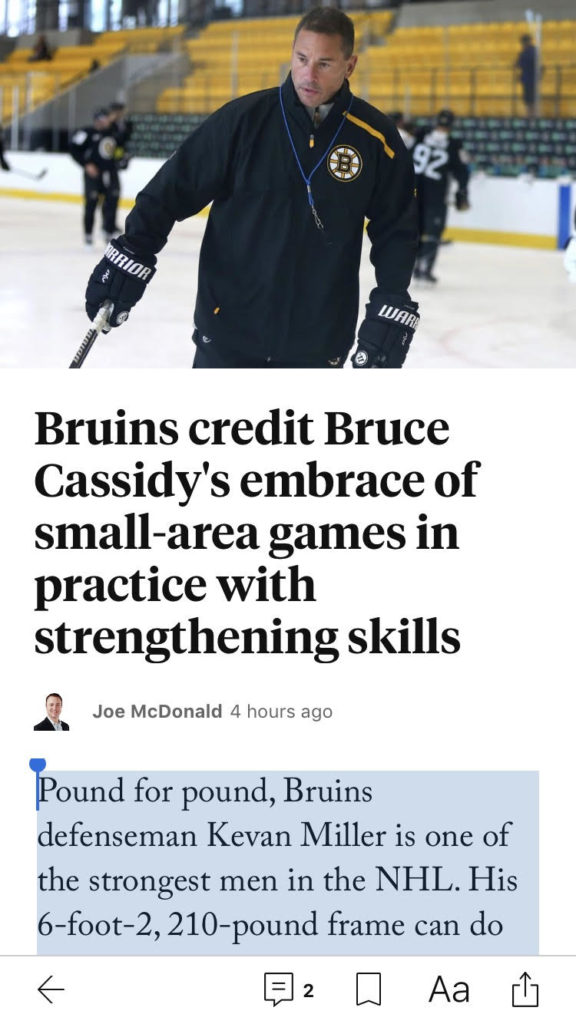NHL Teams Embracing Small Area Games

Pound for pound, Bruins defenseman Kevan Miller is one of the strongest men in the NHL. His 6-foot-2, 210-pound frame can do some serious damage when he collides with an opponent at a high rate of speed in any area of the ice.
When he applies one of his teeth-shattering, eye-popping body checks, his teammates feed off that energy. But, when one of those “opponents” happens to be teammate Patrice Bergeron, everyone winces.
A last-second adjustment from both Miller and Bergeron helped avoid what could have been an ugly collision during a practice drill this week. While the play continued, the two stood for a brief moment at center ice and took a deep breath.
Bruins players understand it comes with the territory, because they practice nearly as hard as they play. That is Bruce Cassidy’s philosophy as a coach, especially when it comes to small-area games.
Small-area games have become the norm at most professional- and college-level practices over the last decade. Small-area games — game-like drills conducted on a reduced portion of the ice — are is designed to help maximize the development of certain skills, including puck support, movement and reaction, when in tight spaces. Cassidy believes it helps the team achieve success.
“It’s something he’s really big on and it’s good to develop skills with not much time and space, because that’s what you have now in the new NHL,” Bergeron said. “It’s been good to be able to have fun and enjoy it at the same time.”
USA Hockey is a major proponent of small-area games at the youth level to teach skills. Many NHL coaches agree with that sentiment, including Cassidy.
“I’ve always enjoyed it,” the Bruins coach said, “for two reasons: A) As a player you like them. It’s competition. You play with the puck. It’s a game. You’re not doing a drill. It’s not a system. You’re playing hockey. B) I think it helps create offense. You’re learning to give-and-go. You’re learning to protect the puck.
“On the other side, you’re learning to defend one-on-one. Try containing (Brad Marchand) in that drill.”
There are numerous and creative ways to apply small-area games during practice. Marchand is one of the most elusive players in the NHL, and many of those skills are honed in this type of setting. Players are forced to make split-second decisions and the atmosphere becomes more game-like.
“It used to be a little bit taboo years ago when I was playing,” explained Cassidy. “Coaches didn’t like to do them as much because they always thought it was a reward. I just think it builds simple hockey, puck protection, puck-defending skills.”
The small-area game Cassidy incorporates most takes place in the neutral zone. Each net is moved up to opposing blue lines for the 3-on-3 battle. If a puck goes past either blue line, a coach puts a new puck in and play continues for the length of a normal shift, which is usually 45 seconds.
It’s a continuous game for 10 minutes.
“You don’t even realize the conditioning you’re getting in,” said Bruins defenseman Matt Grzelcyk. “It can be tough to have those quick, hard shifts. It’s more beneficial than getting bag-skated at the end of practice. It’s more enjoyable for kids as well.
“You have to make plays so much quicker and that’s the way the game is going,” Grzelcyk continued. “Guys at this level are able to know what they’re going to do with the puck, so (small-area games) help you adjust to that speed. If they have more time and space they’ll hold onto it for a little bit longer, but when it’s in a combined space you’ve got to make plays a lot quicker and it definitely translates into today’s game.”
Since the majority of the goals during a normal NHL game are scored close to the net, these small-area games are also beneficial for goaltenders. In a 10-minute, continuous small-area game, goalies see plenty of rubber.
“It keeps guys loose, sharp,” said Bruins goalie Tuukka Rask said. “It helps (goalies) track the puck in tight and being ready for shots all the time. We usually play it at the end of practice when you’re tired and it’s a 10-minute 3-on-3, which doesn’t sound like the best scenario for goalies, but it’s good for tracking the puck.”
The Bruins’ top line of Marchand, Bergeron and David Pastrnak is one of the best in the NHL. Their chemistry, no-look passes and point production are off the charts. Bergeron believes the implementation of small-area games is one reason for his line’s success.
“It helps everyone make quick plays and see what’s open quicker,” Bergeron said. “Having fun at the same time helps, so it’s been good.”
As far as the potential for injuries, Cassidy understands the risks, but the players are aware of their environment (most of the time) and those collisions can be avoided.
“Unless you’re a coach that doesn’t believe in any contact in practice because you want to save the wear and tear — I’m not that guy,” Cassidy said. “We try to balance it. We do a lot of skating early and then do a battle drill or two near the end.”
Whatever in-game benefits the drills bring, they’re also delivering rewards in unexpected ways — like a few new Bruins traditions. Since the ice is so badly chopped up after the drill, if Marchand is on the winning side, it’s not usual for him to celebrate by creating a snow angel near center ice.
